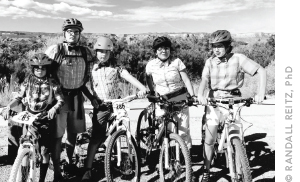
External motivators don’t work for long.
Fam Pract Manag. 2019;26(2):36
Author disclosure: no relevant financial affiliations disclosed. © 2019 Randall Reitz, PhD

I’m the father of three. I’m also a family therapist. You don’t want to be the child of a family therapist. You end up being a guinea pig for your parent’s worst ideas. For example, I’ve often implemented token economies with families I see in therapy. You get a quarter for specific good behaviors; you lose a quarter (or your cell phone) for specific bad behaviors. When I tried this with my kids, it started as a simple job chart on the fridge but grew to include chores, exercise, homework, etc. The kids loved it, earning money for tasks they were required to do anyway. But quickly the system started failing us. The kids would bicker about whether they’d done enough to earn their money, they’d refuse to do things that weren’t on the chart, or they’d say, “No thanks, it’s not worth a quarter.”
About this same time, I watched a TED Talk about intrinsic motivation from Daniel Pink based on his book Drive. It helped me understand not only why my chart was failing my children but also how to build a culture of intrinsic motivation in my clinic. You can read the book to see the research, but the 10,000-foot summary is that people who receive extrinsic rewards for doing their jobs learn more slowly, produce more slowly, and lose their skills more quickly, while those with intrinsic motivation invest more deeply and progress much further. Thus, organizations need to focus on creating a culture of intrinsic motivation through three overlapping pursuits.
1. Purpose: the desire to contribute to something that transcends us. On a clinic level, the shared purpose is delineated in a mission statement. Ensure that your clinic has one, that it was created through an inclusive process, that it is visibly, and that you turn to it when making important decisions. Used effectively, a mission statement will be your practice’s pole star. Staff members should make their own mission statements as well, clarifying their purpose not only in their current position but also beyond.
2. Mastery: the desire to continually improve at something we value. Mastery in a job feels good and builds confidence. It comes from having clearly defined expectations and a process to develop the skills for achieving those expectations. At the most basic level, it requires that staff members receive ongoing feedback, training, and support to remediate shortcomings. At the highest level, it requires that all staff members have personal development plans.
3. Autonomy: the desire to be self-directed. Autonomy is what I value most in my job. It looks like confidence and feels like freedom. However, there is an inherent tension between the desires of professionals to practice in ways that are meaningful to them personally and the desires of leadership to protect the clinic’s mission, productivity, and quality. To manage this tension, clinics should view autonomy as a continuum based on employees’ levels of education, experience, or authority. Higher level employees are typically afforded more autonomy, as are team leads and managers, who need the freedom to build systems and respond creatively to problems. That said, all employees benefit from having some autonomy.
BECOMING YOUR CULTURE
Much like family medicine, my own family is quite diverse, as my wife and I come from different countries and different faith traditions. To reinforce our unique family culture, we often refer to it as “the Reitz way.” I recommend a similar expression as you develop your clinic’s culture around purpose, mastery, and autonomy so that it becomes not just what you do but who you are.
